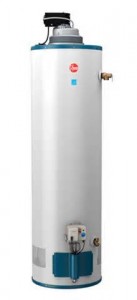Bacterial Growth in Water Heaters
Which Heaters are Safest, and What’s the Ideal Temperature?
Harmful bacteria can grow in water that is up to 122º F. At temperatures of 140º or higher, they are almost completely eliminated. When heaters run at low temperatures (about 99º –human body temperature–would be the worst) water heaters can become virtual hotbeds for bacterial growth. An example of an organism that thrives in the water heater is Legionella (the microbe that causes Legionnaires’ Disease). Surveys have shown that a third of water heaters tested contained Legionella. The organism can cause illness when it is either breath in or ingested during showering. Though you don’t hear a lot about Legionnaires’ Disease, there are between 10,000 and 20,000 cases each year in the US.
temperatures (about 99º –human body temperature–would be the worst) water heaters can become virtual hotbeds for bacterial growth. An example of an organism that thrives in the water heater is Legionella (the microbe that causes Legionnaires’ Disease). Surveys have shown that a third of water heaters tested contained Legionella. The organism can cause illness when it is either breath in or ingested during showering. Though you don’t hear a lot about Legionnaires’ Disease, there are between 10,000 and 20,000 cases each year in the US.
In addition to temperature, the type of heater matters in assessing the risk of Legionella. Gas heaters, which are heated from the bottom and not subject, therefore, to stratification in the tank (hot water rising to the top because it is lightest), are far less likely to support Legionella than electric heaters. Though not a lot of research has been done, bacterial growth in tankless water heaters regardless of the heat source seems unlikely.
The best temperature for your water heater is something of a tradeoff which must consider energy savings (the hotter you run the water, the higher your energy bill), the danger of scalding, and the possibility of bacterial contamination. If you have a tankless heater or a conventional gas heater, low temperatures can be used. With electric, you might choose to run the temperature at 140º and install anti-scald faucets.




